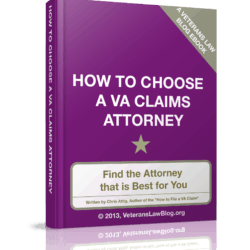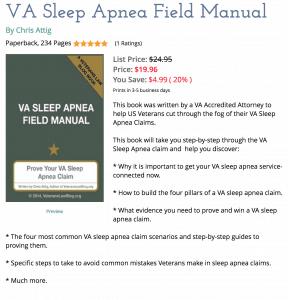If you are going to continue in the Legacy VA Claims Process, you are going to want to bookmark this page to help you remember the steps. A lot of folks are taking down their posts and information about the legacy appeals system, and so this information is going to be harder and harder to find.
Effective February 19, 2019, the VA put into place its Modernized VA claims process. That means that, as of that same date, there are currently two systems that can be used to appeal an adverse BVA decision:
- The pre February 19, 2019, process – also known as the “Legacy VA Claims Process”
- The post February 19, 2019, process – also known as the “AMA VA Claims Process” or the “Modernized VA Claims Process.“
Some folks will tell you that there is a third process, called “RAMP,” but RAMP ended the day the AMA VA claims process went into effect, and any appeal in the RAMP VA Claims Process is automatically part of the AMA VA Claims Process.
By the way, if you are bored and the power has gone out, here is a link to the VA’s August 2018 report implementation of the Legacy VA appeals. There is some very interesting information in here.
You should also know that if you had a claim to reopen an earlier denial awaiting a VA Ratings Decision, you are automatically in the AMA VA Claims Process, and NOT in the Legacy VA Claims Process. This is horrifying, because as I wrote a couple weeks ago, you might have just lost your earlier effective date without even knowing it.
There are certain points in time when you can opt in to the AMA VA Claims Process and leave the Legacy VA Claims Process. I’m not going to discuss those “jumping off points” in this post, and I’m not going to discuss the reasons why you would or would not want to stay in the Legacy VA Claims Process.
What I want to preserve, in this post, are the basic steps of the Legacy VA Claims Process in a nutshell – I’ll discuss what happens at each, below.
VA Regional Office
↧
Board of Veterans Appeals
↧
Court of Appeals for Veterans Claims
↧
Federal Circuit Court of Appeals
↧
Supreme Court of the United States
Step 1: The VA Regional Office (VARO)
The VA Regional Office is the starting point for all VA disability compensation claims.
When a veteran files his or her claim for disability compensation, it used to go to the VA Regional Office geographically closest to the Veteran. Since sometime around 2016-2018, new claims started getting routed into a National Work Queue, so a claim filed in Texas could be processed by a Veterans Service Representative in Portland, Oregon.
In any event, under the Legacy VA Claims Process, the VARO was supposed to:
→ Collect all the service medical records required by law, and all those records relevant to the claim
→Provide assistance to the Veteran in looking for and developing additional evidence in support of the Veteran’s claim.
→ Where necessary or appropriate, send the Veteran for medical exams and opinions to for diagnostic or nexus purposes.
The amount of time the VA Regional Office would take under the Legacy VA Claims Process would vary, depending on the complexity of the claims and disabilities involved, the particular Regional Office processing the claim, and the overall volume of new claims in a given timeframe.
The statistical average was about 9-18 months, but by 2014-2015, we were seeing claims where the VA Regional Office would take more than 18 months to develop and decide the original benefits claim.
A tinnitus claim, for example, will be decided relatively quickly.
A claim related to Agent Orange exposure for a Navy veteran claiming to be a Brown Water Navy Veteran will likely take much longer.
Once the VA Regional Office issued its decision, the veteran (or survivor) had only one option in the Legacy VA Claims Process: appeal to the BVA, or the Board of Veterans Appeals.
Step 2: Board of Veterans Appeals (BVA)
The Board of Veterans Appeals (BVA) is located in Washington D.C.
It is a part of the Department of Veterans Affairs, and essentially provides administrative review of the VA’s denial of all or part of your claim for VA disability compensation. The BVA will tell you that it is not part of the VBA (Veterans Benefits Administration, but if that is true, it’s bureaucratic semantics that we don’t need to worry about. (By the way, here is some bureaucratic semantics that we do need to worry about.)
After the VARO denied all or part of a Veteran’s claim, the Veteran would have to go through a process to “perfect the appeal” to the BVA.
This process – the Notice of Disagreement, the Statement of Case, and the Substantive Appeal – is explained in more detail in other posts on the Veterans Law Blog®.
Under the Legacy VA Claims Process, the veteran or survivor could choose from 4 types of hearings before the BVA – and I encourage you to strongly consider which is best for your VA Claim before you just “check a block and go for the in-person hearing”.
- In-person BVA hearing in Washington, Dc
- Travel Board hearing at the local Regional Office
- Video Conference hearing
- No hearing
The individuals who will decide your claim are called “Veterans Law Judges”, and there are less than 100 of them deciding tens of thousands of claims every year.
For this reason, a BVA appeal can take over 2-3 years to reach decision, from the date of filing your Notice of Disagreement (NOD) to the date that the BVA issues its findings. In an increasing number of BVA appeals, by the end of the Legacy VA Claims Process, we were seeing BVA decision times closer to 5 – 8 years.
The Veteran’s appeal to the BVA would result in any number of outcomes:
- Remand to the VARO for further development
- Reverse the decision of the VARO
- Deny the Veteran relief
- Order its own Independent Medical Exam (IME)
- Any combination of the above.
In the event that the veteran was denied relief, he or she had the option to appeal to the US Court of Appeals for Veterans Claims. This will remain the same under the Legacy VA Claims Process and the Modernized VA Claims Process.
Step 3: Court of Appeals for Veterans Claims
If the Veteran’s claim for disability compensation is denied by the BVA, the Veteran has a specific timeline in which to file an appeal to the U.S. Court of Appeals for Veterans Claims (CAVC).
The U.S. Court of Appeals for Veterans Claims was the product of 38 years of fighting by Veterans advocates and Veteran Service Organizations.
In 1988, the Veterans’ Judicial Review Act of 1988 created this court, to give Veterans a judicial recourse when they were denied benefits.
The Court of Appeals for Veterans Claims can take the following actions in deciding a Veteran’s Appeal:
→ Remand for further development (the Court finds the BVA was WRONG in over 70% of appeals to the CAVC).
→ Affirm the BVA decision (the Court finds the BVA was RIGHT in only 20% of appeals to the CAVC)
→ Reverse the BVA decision (a very rare occurrence);
→ Any combination of the above.
On the Veterans Law Blog®, you will see that I frequently discuss the single judge and precedential decisions of the Veterans Court – in a unique way that teaches Veterans how to USE the Court’s decisions to improve their VA Claims.
Steps 4 and 5: Federal Circuit Court of Appeals & Supreme Court of the United States.
If the Veteran loses at the Court of Appeals for Veterans Claims, the Veteran can appeal certain matters to the Federal Circuit Court of Appeals, and, ultimately, the United States Supreme Court.
These types of appeals are very rare, and are usually only available to challenge improper interpretations of the laws, rules and regulations in a Veterans’ claim.
It is very, very difficult to get the Federal Circuit to take jurisdiction over an appeal from an adverse decision of the Veterans Court, and an even smaller of those cases will result in remands or reversals. Here are the most common outcomes in appeals to the U.S. Court of Appeals for the Federal Circuit:
Dismiss for Lack of Jurisdiction
“Rule 36” decision (an order affirming the opinion of the Veterans Court with no explanation)
Non-precedential remands, reversals and affirmances. These are decisions of the Federal Circuit that are unique to the particular fact pattern in a particular case.
Precedential remands, reversals, and affirmances. These are decisions of the Federal Circuit that apply to all future VA claims and appeals, and in some cases, retroactively to other VA Claims or Appeals.
After the Federal Circuit is the US Supreme Court. Since I started practicing Veterans Law in 2007, I have seen only a very small handful of Veterans disability compensation claims go to the Supreme Court. They typically involve massive legal questions that affect the law outside of the Veterans arena as well.
Appeals to the U.S. Supreme Court are discretionary. That means that the SCOTUS gets to decide what cases it does and doesn’t want to hear or decide.
To seek review, a petitioner must first seek the writ of certiorari, or in plain English, seek to have their review of the lower Court certified by the Supreme Court. It will then be argued and, in most cases. In rare situations, SCOTUS will grant cert, take briefs and argument in a case, and then dismiss the appeal because certiorari was “improvidently granted.” Basically, the 9 Justices just decided the didn’t want to decide the case after all.
Where can Veterans Learn More about the VA Claims Process.
Here are 2 ways that you can learn a lot more about the VA Claims Process – whether it is the Legacy VA Claims Process or the Modernized AMA VA Claims Process:
#1: Become a subscriber to the Veterans Law Blog®. You can join as a monthly member, or get a big discount by pre-paying for a full year. Your subscription, monthly or annual, will automatically renew at the end of the period so you don’t need to worry about missing a single post from the Veterans Law Blog®. Click here to get a free 7-day trial subscription.
#2: Check out my eBook: Climbing the VA Claims Process. This book was meant to preserve the Legacy VA Claims Process so that those veterans who choose to stay in it will have the resources to navigate the Old VA Hamster Wheel. Click here to take a look at this eBook.





